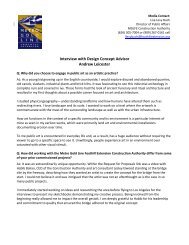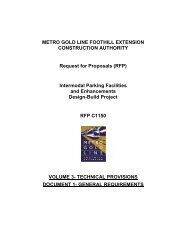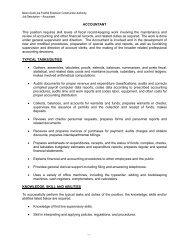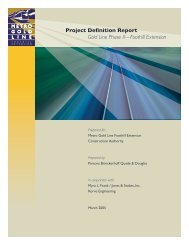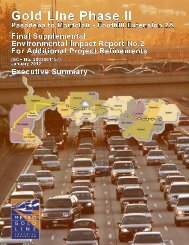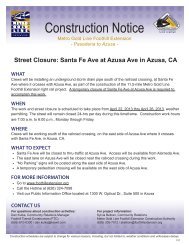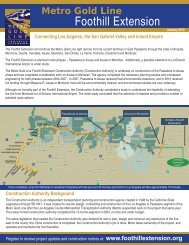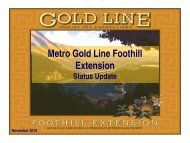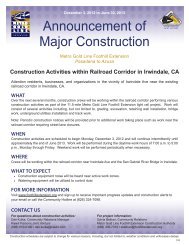Part 3 - Metro Gold Line Foothill Extension
Part 3 - Metro Gold Line Foothill Extension
Part 3 - Metro Gold Line Foothill Extension
Create successful ePaper yourself
Turn your PDF publications into a flip-book with our unique Google optimized e-Paper software.
Noise and Vibration Technical Report: <strong>Metro</strong> <strong>Gold</strong> <strong>Line</strong> <strong>Foothill</strong> <strong>Extension</strong>, Azusa to Montclair<br />
July 2012<br />
Page 111<br />
LSTM Measurement Results<br />
Figure 38: The FDL for <strong>Metro</strong>link Trans<br />
The vibration propagation tests were performed at seventeen locations throughout the proposed project<br />
corridor. The locations of the tests and the measurement results, sorted by city, are presented in Section 2.<br />
This section presents the best-fit and worst-case curves derived from those measurements and applied in<br />
the prediction models.<br />
Best-fit curves were fit to the data of each 1/3 octave band of the different measurement sites. The best-fit<br />
curves were used to compare the results from all of the sites and develop worst-case curves that could be<br />
applied throughout the corridor. After inspection of the results, the LSTM results were separated into<br />
three groups: Glendora, San Dimas/La Verne, and Pomona/Claremont. The best fit results, presented by<br />
city, are shown in Figure 39 through Figure 41 below.<br />
A worst case curve was developed for each group by using the highest value in each 1/3 octave band for<br />
that group. The worst case curves for each group are shown in Figure 42 below. The worst case curves are<br />
used in the vibration prediction models to ensure that the vibration levels are not under predicted at the<br />
sensitive receivers.



